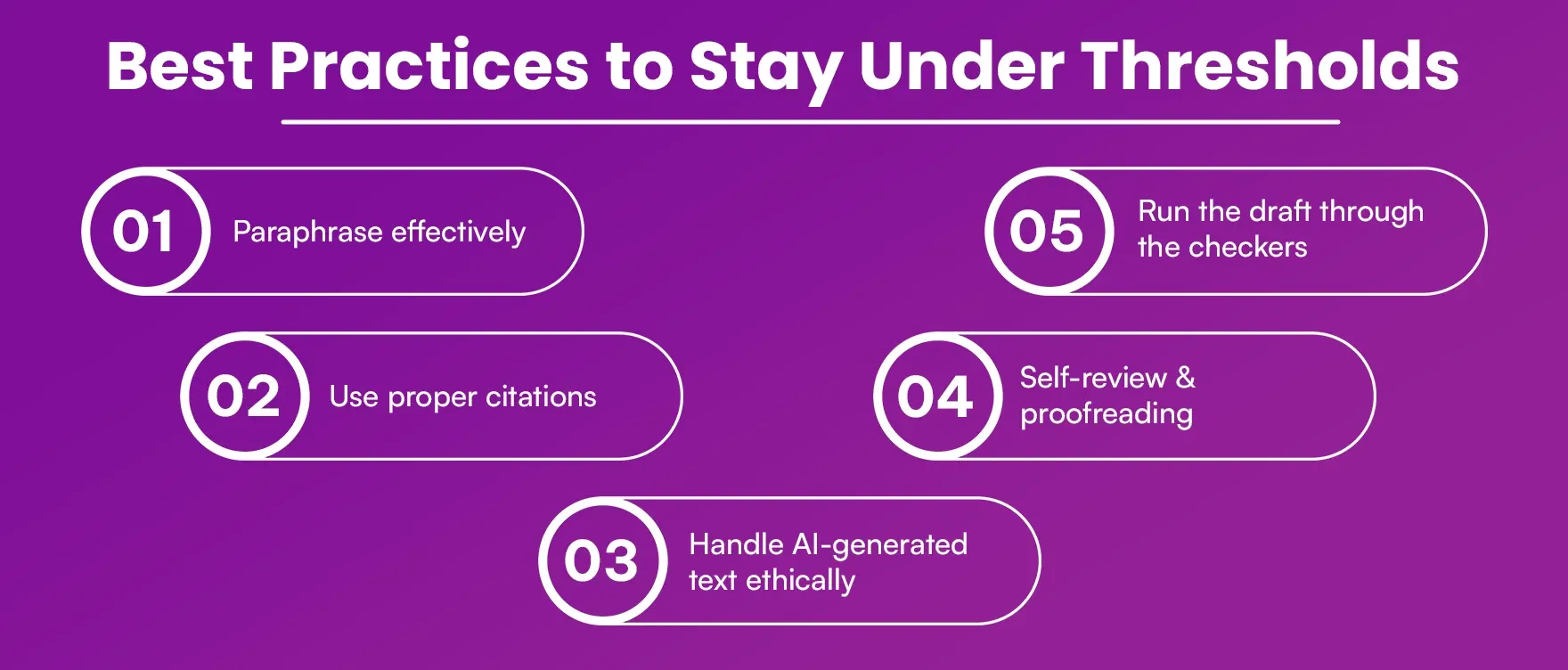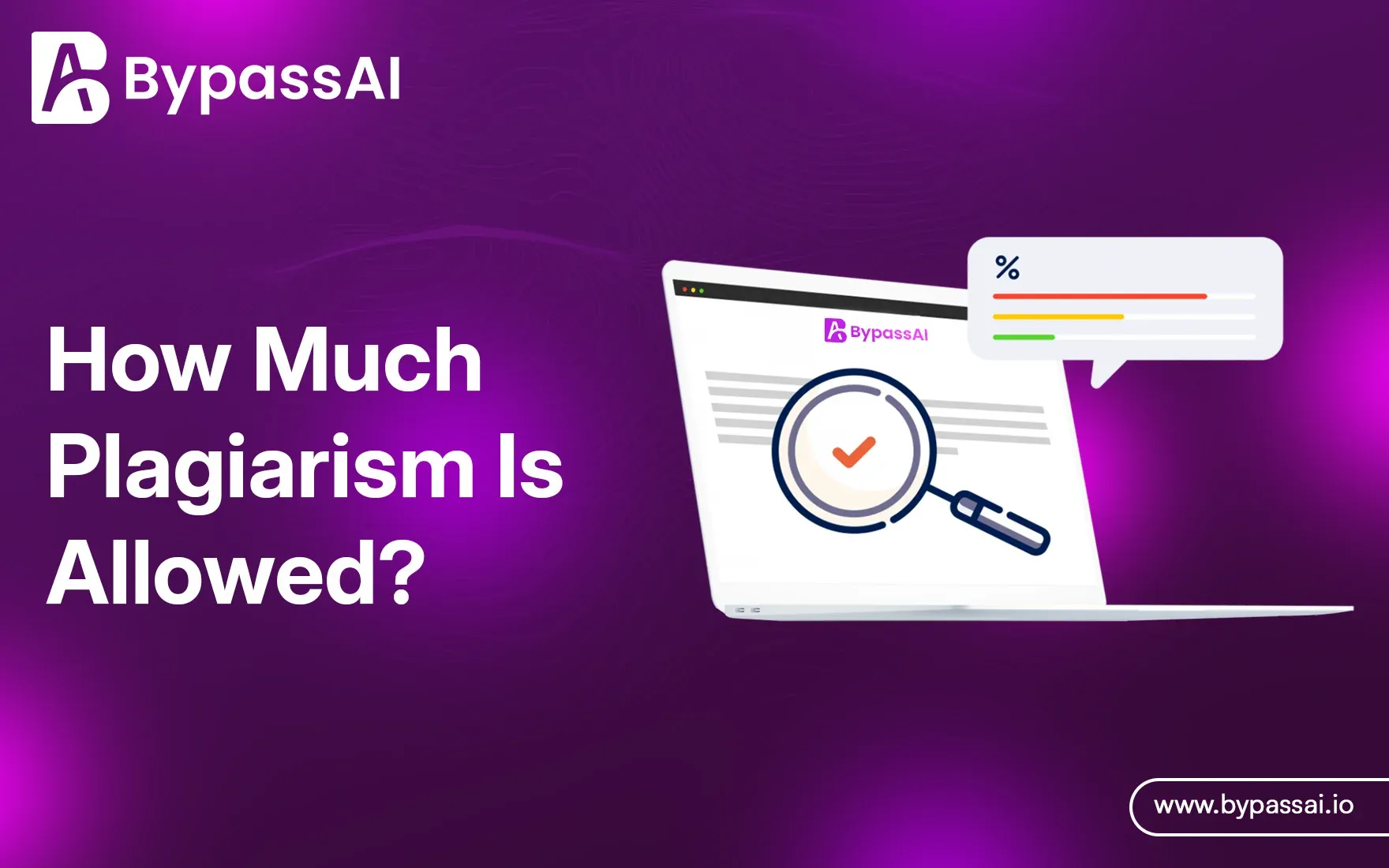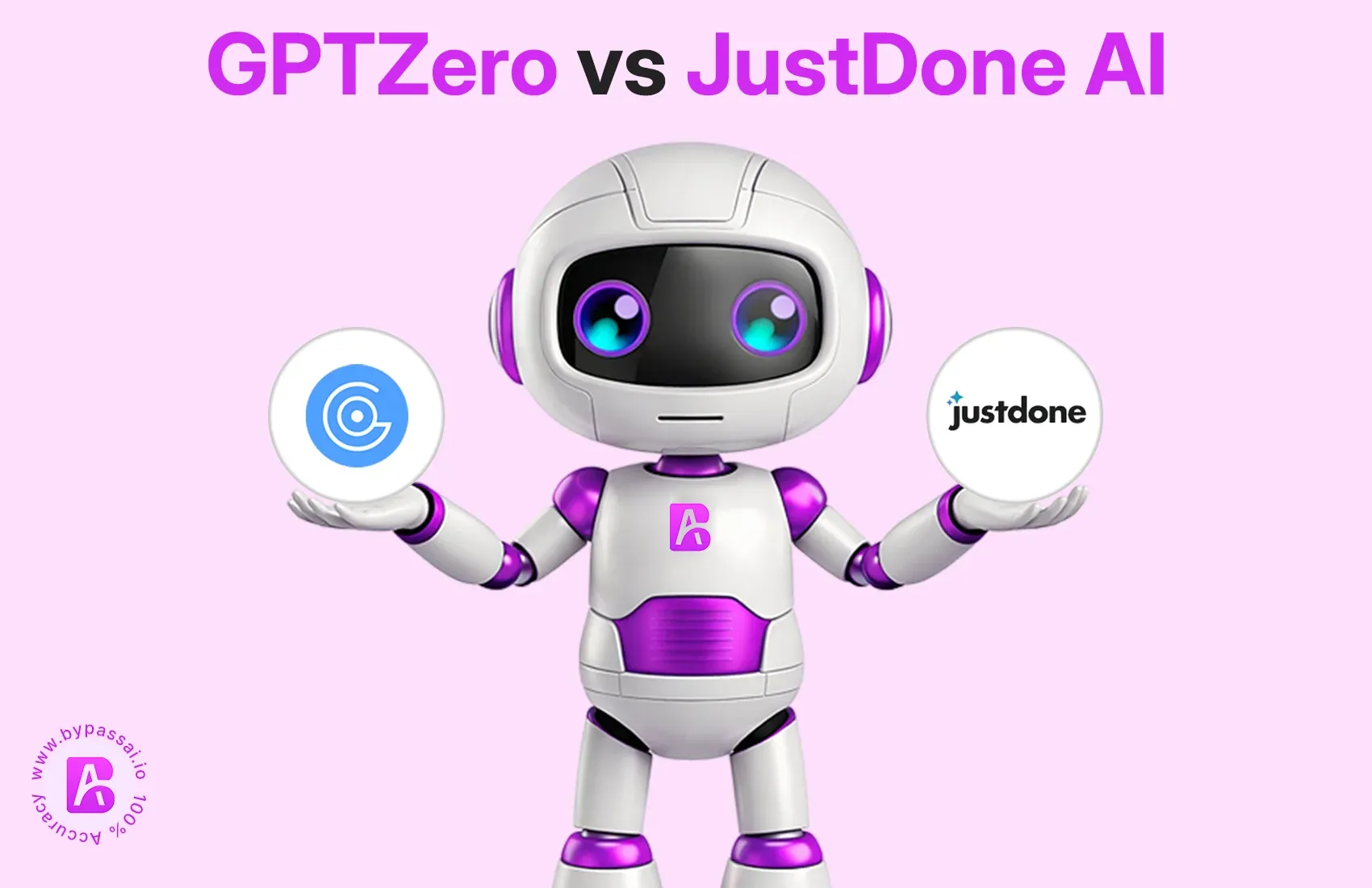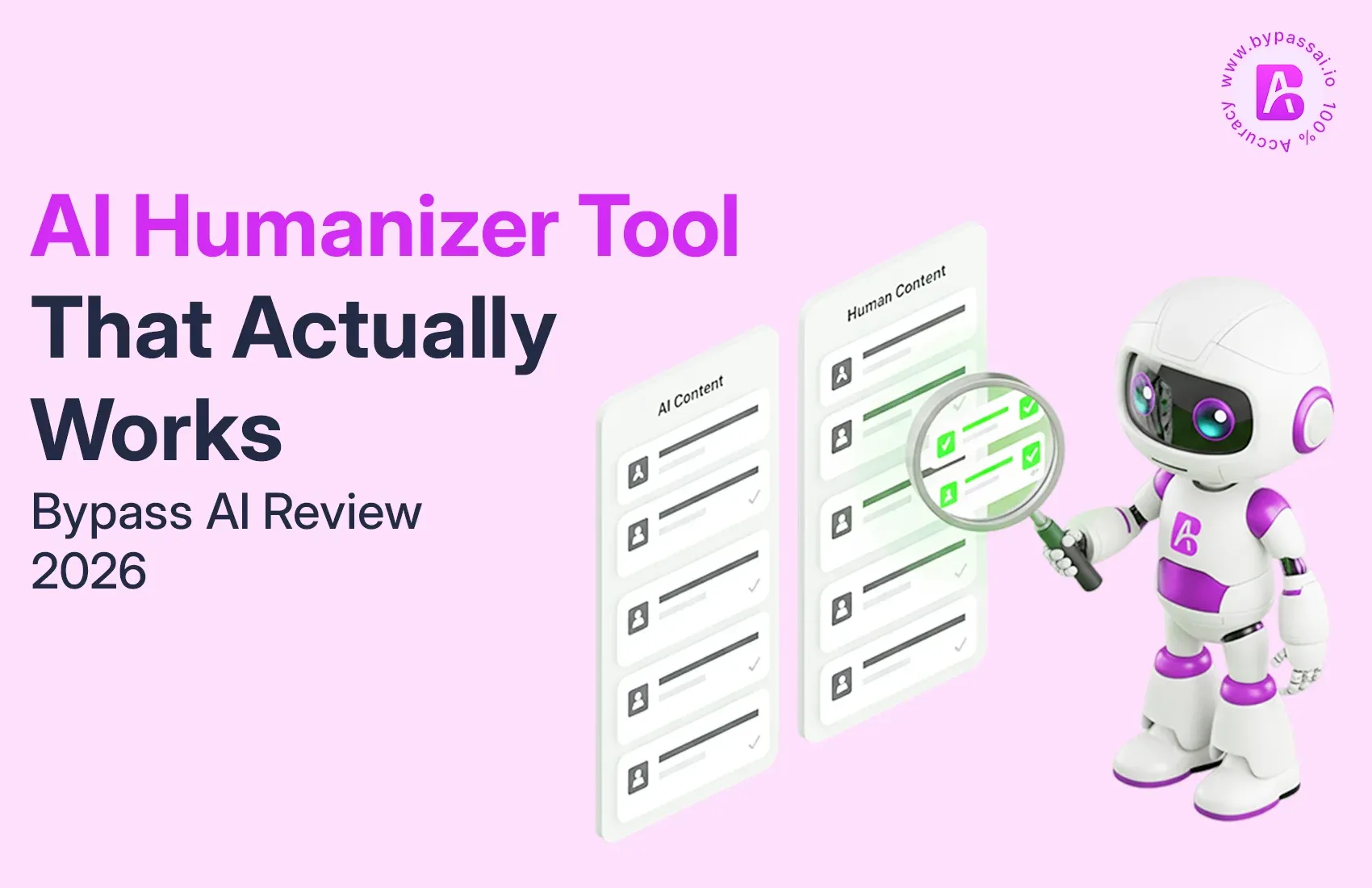Sign In
Welcome to Bypass AI! Sign in to continue your exploration of our platform with all its exciting features.
Forgot Password?
Don’t have an account ? Sign up
Sign Up
Embrace the Future with Bypass AI! Sign up now and let's rewrite the possibilities together.
You have an account ? Sign In
Enter OTP
We’ll send you an OTP on your registered email address
Back to Login
Forgot Password
We'll Send You An Email To Reset Your Password.
Back to Login
Enter OTP
We'll send you an email to reset your password.
Back to Login
Confirm Password
Please enter your new password.
TABLE OF CONTENTS
Quick Summary
What Is Plagiarism and Why Does It Matter?
Zero‑Tolerance Principle
Setting Institutional Thresholds
Similarity Tools Interpret Matches
Content Type and Allowable Percentages
Best Practices to Stay Under Thresholds
Using Plagiarism Detectors Wisely
Conclusion
FAQs
There is no such thing as plagiarism in this digital age, it is an ethical and professional concern. Whether a thesis, article, or web content is being submitted, originality should be guaranteed. But, the actual question is this, how much plagiarism is allowed before it is deemed a problem?
This guide explores what plagiarism really means, how it is measured, and what percentage of plagiarism is acceptable for each case, depending on the type and context.
Quick Summary
Plagiarism is the act of presenting the work or ideas of someone else as one's own-whether inadvertently or wilfully. In an ideal world, there would be no plagiarism; however, various institutions and platforms do permit a certain percentage of plagiarism threshold given common phrases, citations, or technical jargon-these thresholds range from about 5% to 25%, although they may differ based on the type of source, field, and tool used for checking.
What Is Plagiarism and Why Does It Matter?
Plagiarism transpires when you repeat another person’s content, whether it be a sentence or a paragraph, or even an idea-without proper attribution. It is a type of intellectual theft and has serious consequences, with expulsion from the school being one of such punishments, not to mention professional discreditation or legal action.
Within academia, it may invalidate your entire research, while in SEO and digital marketing, it can hinder your website’s credibility and rank. In journalism, it's simply the death of goodwill with a reader. So, a student, a content writer, or a businessperson: a clear idea of what percentage of plagiarism is acceptable is crucial for maintaining integrity.
Zero‑Tolerance Principle
Some institutions operate under zero-tolerance policies-that is, no plagiarism at all, whether intentional or accidental (or should I say accidental!). This mindset is generally entertained in better universities, medical journals, legal institutions, and research organizations, where originality is simply a must-have.
Even a work with a lot of citations may get flagged if it excessively depends on others' works. For example, if your paper contains a long stretch of quoted material, even if cited correctly, it might still indicate a high plagiarism score for less original content.
Setting Institutional Thresholds
Plagiarism is not outlawed in any one particular institution or platform. Practically all settings would give certain margins of similarity, provided the copied contents are:
- Cited properly
- Used in moderation
- Not decreasing the originality and intention behind the work.
Here is what each sector may accept in reason:
- Institutions may allow up to 10-15%
- Journals may accept less than 5%
- Corporate blogs or SEO articles may tolerate up to 20-25%
- Books and other long-form content tend to be more lenient, depending on references.
It is always best to check an institution's or publisher's explicitly written plagiarism policy to keep clear of unnecessary penalties and be on the right side of the law in the eyes of those who review your writing.
Similarity Tools Interpret Matches
Many people tend to think that a 10% plagiarism report means 10% of their content has been copied. Such an inference is not quite right.
Plagiarism detection tools (such as Turnitin, Grammarly, or Originality.AI) identify similarity rather than intention. They highlight matching text within their database of source materials, but cannot ascertain whether the text is plagiarized or properly quoted.
Your bibliography, direct quotations and common expressions may indeed appear as matches, though not necessarily plagiarized instances. Most tools even allow excluding quoted or referenced materials from the final score, and so get a refined measurement. An understanding of how these tools interpret the percentage will help you determine what percentage of plagiarism is acceptable to you in your context.
Also read this article : Best Plagiarism Checkers for Teachers
Content Type and Allowable Percentages
Different styles of writing accept different thresholds. Here is a general guide, based primarily on the style, of what type is minimally acceptable:
| Content Type | Typical Acceptable Similarity |
|---|---|
| Essays / Term Papers | 15–25% |
| Theses / Dissertations | 5–15% |
| Published Journals | 5–15% |
| Research Papers | 20–25% |
| General Academic Writing | 15–20% |
Best Practices to Stay Under Thresholds
If you want to stay within safe security margins concerning plagiarism, below are some practical methods to consider:

1.Paraphrase Properly
Paraphrasing isn't just about words being changed here and there; in skills, it is about fully rewriting a concept using your voice while maintaining the original meaning. A common mistake is to let technologies do all the work-AI tools such as QuillBot and Spinbot sometimes give a weird phrasing or lead to detection. Good paraphrasing includes reading the original piece very well, grasping the main idea, and then explaining it as if to another person-which decreases the similarity score and presents real understanding of the subject matter.
2. Citations Have to Be Properly Done
Any time any literature, direct quote, idea, datum, or even a paraphrased view from any author is referred to, a proper citation must be given. A failure of this leads to even the slightest mention of information becoming an act of plagiarism. Employ a standard format such as APA, MLA, Chicago, or Harvard as per the requirements of your institution or publisher. In-text citation, as well as bibliography or reference list, are necessary to clarify to the reader which portions of a text are backed up by external sources and which are your contributions. This way, earlier work is given due credit, and herewith, it would impinge on keeping your work ethical and professional.
3. Ethics of Handling AI-Generated Text
There are some AI services assisting content creators with drafting, making content creation a bit easier, yet with all such AI-based drafting facilities, there is a plagiarism risk involved. When you employ AI to draft your content, it is important to review and rewrite the output and ensure that no existing works get copied to any significant extent. Never publish what the AI presents as it is. They are only meant to act as starting points that you use to bring in your ideas, experiences, and voice so that a truly authentic and engaging text results. This way, the risks of getting flagged for copyright infringement are greatly minimized.
4. Self-Review and Proofreading
Consider always conducting a thorough self-review before submitting or publishing work. Reading aloud allows for the detection of robotic phrasing, repeated ideas, or sections that may sound too similar to one source. Structural issues or missing citations may also appear. This proofreading greatly reduces grammar errors and also assists in ensuring the originality of the text, should certain sentences be copied and pasted without any revision. This step becomes very, very important when multiple sources are being juggled.
5. Use checkers for extra safety
The most practical and cost-effective approach is to check the plagiarism level of your content before submitting it with a reliable plagiarism checking tool. Such tools include Bypassai, Turnitin, Grammarly, Originality.AI, and PlagScan; once your document is scanned, you get to see the percentage similarity. Some tools will also highlight the matched text for you and provide a list with the sources so that you can determine what needs to be edited or cited. This service can be rendered on early drafts, giving you time to make revisions, thus ensuring your final work falls within accepted thresholds.
Using Plagiarism Detectors Wisely
Plagiarism detection tools are a tremendous asset when correctly used. Keep in mind the following:
- They determine the level of similarity, never the intention
- Cannot measure tone or writing quality
- Occasionally, false positives can appear (citations, bibliography, or common expressions)
Use software as an aid in your writing, rather than peremptory. You are ultimately responsible for maintaining originality and integrity.
And never get caught using just a single tool! Some cross-checking with two detectors might shed some light, especially when the different tools are accessing different databases. Students would particularly benefit here, especially if trying to submit with Turnitin and SafeAssign simultaneously.
Conclusion
How much plagiarism is allowed? Zero plagiarism being the standard, practical limits vary with the context. In most academic and professional writings, plagiarism is considered acceptable at between 5% and 20%, given that it is properly cited and is not intentionally copied.
However, one must know one's audience and the expectations, use plagiarism tools in a correct manner, and value original thought above anything else. Through following best practices such as paraphrasing, citing sources, and double-checking, our levels of plagiarism will stay low while our credibility remains high.
If you're a student trying to achieve a clean Bypassai report or a content marketer assuring SEO originality, then it's about time you learn just what percentage of plagiarism is acceptable, the very first step toward ethical and genuine writing.
FAQs
1. How much plagiarism is acceptable in colleges?
Most universities will accept up to about 10–15% plagiarism if it has proper citations and references. Beyond this point, however, the document would have to be revised or subjected to some penalties.
2. Is 20% plagiarism bad?
Well, it depends on context. In an academic paper, usually 20% is a bit high. But in articles or SEO content, 15-20% can be quite amicable if there are technical terms or some attributed quotes in there somewhere.
3. Do tools give false positives?
Yes. Often, they flag the bibliography, direct quotes, or common phrases. Most checkers allow you to try to exclude these from the final report to get a more accurate percentage.
4. Can I go with AI tools such as ChatGPT without getting flagged?
You could, but it's a dangerous gamble. Since AI tools can generate content either identical or nearly identical to an online source, paraphrase and cite the source from which you take the information, and check the output with a plagiarism detector.
5. Is 5% plagiarism acceptable?
Yes. In most cases, 5% plagiarism is permissible if the matches are citations or references. It is generally an acceptable figure for all industries.




